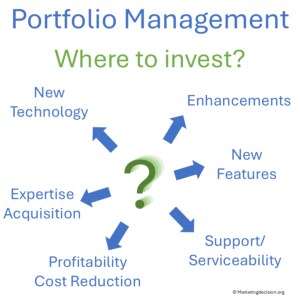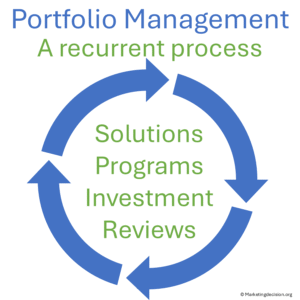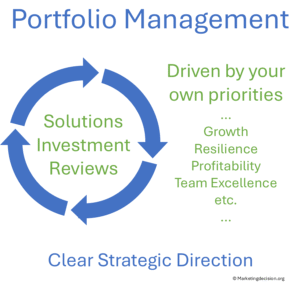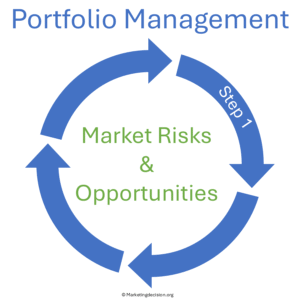 Portfolio management involves making decisions about the company’s investment budget and allocating different budget lines to the development of solutions and the technology components that make up those solutions. It can also include investments in sales and service, for example, when the goal is to expand into new market segments that require specific sales and service infrastructures.
Portfolio management involves making decisions about the company’s investment budget and allocating different budget lines to the development of solutions and the technology components that make up those solutions. It can also include investments in sales and service, for example, when the goal is to expand into new market segments that require specific sales and service infrastructures.
Therefore, portfolio management is not limited to products or solutions; it also includes technology and other resources required to deliver new solutions to the market. All aspects requiring investment—whether material or immaterial—should be considered. The evaluation of return on investment should broadly include all activities essential for introducing a solution to the market.
 Portfolio management is an ongoing process. Teams regularly present proposals that are reviewed, discussed, and, when validated, shape the next generation of solutions. It is a recurring process, conducted regularly to review programs with the goal of reorienting investment budgets as needed.
Portfolio management is an ongoing process. Teams regularly present proposals that are reviewed, discussed, and, when validated, shape the next generation of solutions. It is a recurring process, conducted regularly to review programs with the goal of reorienting investment budgets as needed.
It is essential to ensure that a clear strategic direction is set, and that company priorities are aligned with key criteria such as growth, profitability, risk reduction, innovation, team development, and skills utilization. Companies should define their own objectives and goals, revisit them regularly, and ensure that management teams are clear on the level of risk they are willing to take and how investment programs align with these objectives..
 Portfolio management requires decision tools similar to those discussed in the Decision chapter. In many ways, it shares similarities with setting up a marketing plan, as both focus on aligning objectives and strategies across the organization.
Portfolio management requires decision tools similar to those discussed in the Decision chapter. In many ways, it shares similarities with setting up a marketing plan, as both focus on aligning objectives and strategies across the organization.
Portfolio management is similar in its approach and objectives, but it typically has a narrower focus on solution development and follows a faster cycle with frequent reviews through intermediate progress assessments.

The process can be structured in four steps, similar to the development of a marketing plan. These steps can be adjusted to fit your company’s organization.
Companies with independent business segments may divide the work by internal division, but final consolidation will still be necessary:
 A review of market risks and opportunities is a valuable first step in identifying growth areas, whether through new solution offerings (systems or optional features), new technology, or new go-to-market strategies.
A review of market risks and opportunities is a valuable first step in identifying growth areas, whether through new solution offerings (systems or optional features), new technology, or new go-to-market strategies.
Actions to support this analysis include a market share analysis to determine which segments are growing faster than others and where a company can consistently outperform the competition. It’s often overlooked that market segments growing just a few percentage points faster than others can become significantly stronger over time. For this reason, it is important, if not critical, to invest in technology and solutions that target faster-growing, profitable segments while maintaining a presence and minimizing investments in declining segments.
Understanding the strengths and weaknesses of competitors is crucial for assessing the future success of new solutions. A competitor’s potential weakness can offer a unique opportunity to gain a market advantage, while a strength could become a roadblock to new product or technology development. However, relying on past data alone to predict the future can be misleading. Instead, the focus must be on customers—their needs and expectations. Developing solutions that meet their future needs will align the company more closely with the market.
 The “why” for this step is to decipher the market, identify opportunities, understand customer needs, and create a comprehensive view of the market landscape, including competitors.
The “why” for this step is to decipher the market, identify opportunities, understand customer needs, and create a comprehensive view of the market landscape, including competitors.
The “what” forms the foundation for the next steps, where multiple solutions will be shared and discussed. This step is critical, and all team members must understand it thoroughly. Since data is often incomplete or not fully validated, the overall analysis will combine both objective and subjective content. This is where marketing must excel—delivering an honest and clear synthesis while ensuring uncertainties remain visible to all. Many of the points shared in the Decision chapter on marketing program development apply to solution development. The key difference is that marketing plans are typically developed with a longer time horizon and focus on the company as a whole, whereas solution development is a continuous effort where teams optimize investment spending within their business or market segment scope.
The “how” involves tools and techniques that help deliver the “what.” Tools from the Decision and Market chapters are particularly useful for this purpose. For instance, scenario planning is an effective method for deep, forward-looking assessments, keeping assumptions in focus. What if a competitor introduces a new technology now or in three years? What if a new entrant arrives? These and other critical questions can be addressed, allowing for further discussions in Step 2 and Step 3 when solutions are debated and selected.
Other useful tools include those already mentioned, such as PESTLE, Porter’s Five Forces, Risk and Opportunity Matrix, Technology vs. Product/Solution Innovations, and many tools outlined in the market and customer sections.
Three additional tools are worth considering for Step 1: Identification of Market Risks and Opportunities:
 Value Mapping – This tool is very effective for determining the relative perception of a company’s and competitors’ solutions in the market. It’s crucial because solutions considered for launch may become obsolete if their price is undercut by competitors. No solution with the same perceived value as competitors can last long if it isn’t competitively priced. Cost is a critical factor in a solution’s viability.
Value Mapping – This tool is very effective for determining the relative perception of a company’s and competitors’ solutions in the market. It’s crucial because solutions considered for launch may become obsolete if their price is undercut by competitors. No solution with the same perceived value as competitors can last long if it isn’t competitively priced. Cost is a critical factor in a solution’s viability.By investing in a 360° view of the market, teams can challenge assumptions made in previous periods. Are those assumptions still valid? What actions have competitors taken? Have they introduced new solutions or technologies? What are the new market growth opportunities? Where is profitability? What about the objectives and targets set by the company?
 Teams responsible for segments and solutions will generate program proposals and provide supporting arguments, including a description of both external and internal risks.
Teams responsible for segments and solutions will generate program proposals and provide supporting arguments, including a description of both external and internal risks.
The first step involves assessing opportunities in relation to the market environment and competitive moves. This assessment is crucial for identifying early market opportunities, understanding their growth or decline, and recognizing market changes, including shifts in customer behavior.
Using a common format for solution proposals is beneficial for straightforward readability and comparison. Similar to the format proposed, a presentation that clearly outlines the “why,” “what,” and “how” of solution development is both clear and simple to use.
 Why: This section articulates the benefits of the proposed solution within the context of the market environment. It answers the question: Why is this an opportunity? This part may include both objective and subjective elements. Estimated benefits, such as ROI (Return on Investment) calculations, are important to include.
Why: This section articulates the benefits of the proposed solution within the context of the market environment. It answers the question: Why is this an opportunity? This part may include both objective and subjective elements. Estimated benefits, such as ROI (Return on Investment) calculations, are important to include.This format should be easy to present and discuss, avoiding lengthy presentations whenever possible while keeping the data accessible upon request. The goal is to ensure that all projects can be evaluated on an equal basis. After describing the market opportunity and discussing the project scope and deliverables, company management can make informed decisions to approve, postpone, or dismiss a project.
 Program prioritization can follow various decision-making schemes. Multiple tools are available for this purpose, some of which are discussed in the Decision chapter. Projects may vary in scope: some may require long-term investments and sustained funding, while others may be short-term with smaller investments that are often straightforward decisions. However, an excess of smaller-scale projects could jeopardize the funding needed for larger, yet crucial, long-term initiatives.
Program prioritization can follow various decision-making schemes. Multiple tools are available for this purpose, some of which are discussed in the Decision chapter. Projects may vary in scope: some may require long-term investments and sustained funding, while others may be short-term with smaller investments that are often straightforward decisions. However, an excess of smaller-scale projects could jeopardize the funding needed for larger, yet crucial, long-term initiatives.
Using a diagram to illustrate ease of implementation versus impact can be a helpful tool for discussions. This visual aid allows for clear comparisons and facilitates decision-making. Another useful diagram is one with two axes representing new market investments versus technology, which is also practical for evaluating projects.
Engage teams in offering solutions and recommendations regarding investment decisions. Pose “what if” scenarios to assess alternative approaches in case of adverse situations or, conversely, to explore opportunities when positive and impactful events occur.
New technology breakthroughs, new competition, and new solutions entering the market require careful attention, just as much as price, distribution, and communication do. This comprehensive view of the market situation is a part of marketing plan development and supports the assessment of company strengths and weaknesses.
Ensuring an excellent customer experience is key to generating long-term partnerships and ensuring your customers become your best allies in selling your solutions.
 This step involves regularly evaluating the execution of the program. The primary focus is to assess whether the investment funding is being used effectively. Programs should be evaluated based on their performance, and lessons learned should be shared among teams to ensure best practices are repeated and recurring issues are avoided.
This step involves regularly evaluating the execution of the program. The primary focus is to assess whether the investment funding is being used effectively. Programs should be evaluated based on their performance, and lessons learned should be shared among teams to ensure best practices are repeated and recurring issues are avoided.
Budget allocation is crucial and requires careful attention to both overestimated and underestimated budgets, as these can lead to inefficiencies. An underestimated budget will require additional funding to complete the program, while an overestimated budget can divert resources from other important projects.
Portfolio management is a core activity where a company evaluates its approach to solutions development and makes both short- and long-term investment decisions. By establishing consistent mechanisms, teams from various business functions can stay coordinated and collectively make key decisions.
© marketingdecision.org
The following section may include tools, some free, some with a fee to support this site development. If you consider a tool should be presented in this section and is missing, please let us know at: contact@marketingdecision.org
© 2025 MARKETING DECISION SOLUTIONS. All Rights Reserved.